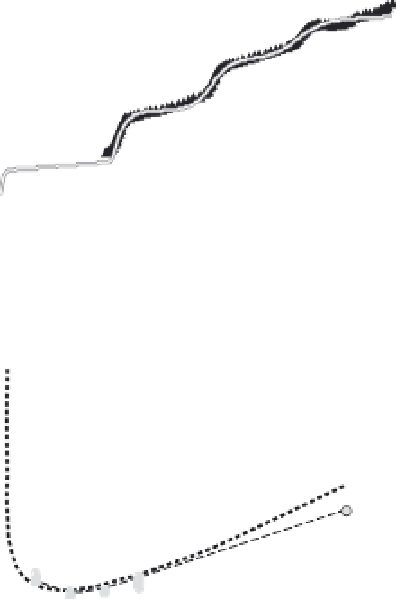Geology Reference
In-Depth Information
sediment accumulates from upslope. In contrast,
rounding of the top of the slope requires weath-
ering of the rock to produce sediment that can
then be passed downslope. If weathering is slow,
the rounding of the crest is slower than the
rounding of the base, and the profile becomes
asymmetric. Especially at early times, the sharp
curvature at the hillcrest (or scarp crest) results in
rapid removal of the existing regolith; thereafter,
the rate at which this portion of the slope declines
is dictated by the weathering rate on bare bed-
rock, i.e., it is
weathering limited
. All the while,
the material transported downslope forms the
smoothed colluvial apron at the base of the slope.
Given that this time lag in producing
transportable material could potentially explain
the asymmetry of the marine terrace risers
studied by Hanks
et al
. (1984), Rosenbloom and
Anderson (1994) incorporated such a rule set
into their models of hillslope evolution and
demonstrated that considerably better fits to the
profiles could be achieved when both weathering
and diffusive surface processes were treated
explicitly (Fig. 11.9). It was not necessary to
appeal to surface processes that resulted in
nonlinear diffusion.
In an application to glacial moraines, which
have been used in eastern California to con-
strain both the ages of the glaciations and slip
rates on the Sierran frontal fault (Bursik and
Gillespie, 1993), Hallet and Putkonen (1994)
have shown that the interpretation of cosmo-
genic radionuclide (CRN) results from boulders
on moraine surfaces is not straightforward. They
argue that use of a numerical model of moraine
evolution that employs a slightly modified form
of the diffusion equation described previously
can fit the moraine topographic profiles. By
tracking, in addition, the build-up of cosmogenic
radionuclides in boulders that are slowly
exhumed from within the moraine during its
shape evolution (see Chapter 3), they show
that: (i) on old moraines, the boulders com-
monly used to date them should yield only a
minimum age for the moraine; and (ii) the mean
200
A
Marine Terrace Profile
150
observed profile
modeled
100
profile
pristine abrasion
platform
50
0
B
Regolith Depth
20
0
0.0
0.4
0.8
1.2
1.6
2.0
Horizontal distance (km)
10
C
Diffusivity
8
Majors profile
Baldwin profile
6
optimized
diffusivity
4
2
0
0 0 0 0 0 0
Diffusivity (m
2
/ky)
Fig. 11.9
Santa Cruz marine terrace profiles.
A. The observed stair-stepped topography of marine
terraces in Santa Cruz, California, are assumed to be
underlain by a wedge of sediment that is a combination
of original marine terrace deposits (here assumed to be
uniformly 6 m thick upon retreat of the sea) and
colluvium derived from the decay of the sea cliff
backing any particular terrace. These wedges overlie
“pristine abrasion platforms” that are inserted into the
model at the distances required by the locations of
observed paleo-sea cliffs and at the times prescribed by
the assumed ages of the sea's abandonment of the inner
edge of each terrace. B. The regolith depth as a function
of position. Note the spike associated with the base of
the cliff and the taper that grows through time. Regolith
is absent on the bedrock-dominated edge of the first
cliff, but has a finite but low depth on the upper edges
of older cliffs. The terrace surfaces of old or narrow
platforms dip significantly more steeply toward the sea
than do younger and broader surfaces, suggesting that
caution is warranted in interpreting dips of these
surfaces as tilt of the original platforms. C. Sensitivity
analyses of the diffusion parameters controlling the
shapes of the model hillslope profiles. Tests used the
reduced
c
2
statistic relating model calculations to real
data. For both surveyed profiles, the minimum
c
2
corresponds to
k
= 10 m
2
/kyr. Adapted from Rosenbloom
and Anderson (1994).




























































































































